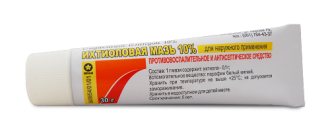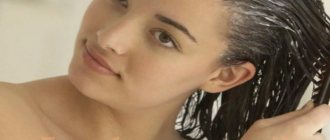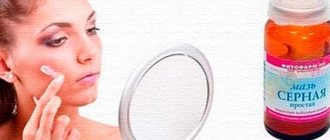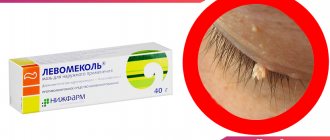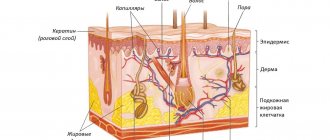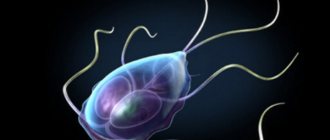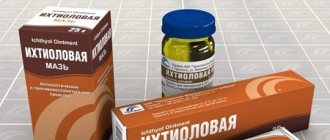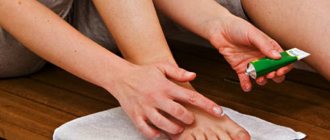Frequent contamination, irritation or mechanical damage to the skin, microscopic wounds and scratches, increased activity of the sebaceous and sweat glands, decreased immunity and lack of vitamins - all these factors can lead to the formation of boils on the body, foci of suppuration and the development of infection.
It all starts with a small nodule, which can easily be confused with a pimple, however, over the course of several days it increases in size and turns into a rather painful abscess.
A boil (popularly called a “boil”) can form on almost any part of the body, and as a rule, when it appears, we are in no hurry to see a doctor. It is strongly recommended to visit a specialist if a boil occurs on the face, since the spread of pus deep into the tissues is especially dangerous here.
If the boil does not form in the area of the nasolabial triangle and the abscess is small, then in this case it is possible to carry out treatment at home with the obligatory observance of all hygiene rules. The treatment procedure consists of treating the inflamed area with an antiseptic drug and then applying ointment for boils.
Levomekol ointment is recognized as one of the best in the fight against boils.
Levomekol has proven itself well over its long existence on the Russian market. This is an external use product that has an antibacterial effect and at the same time helps restore tissue structure.
In addition, a separate advantage of the ointment is the fact that, while healing the affected area of the skin, it does not have a negative effect on the entire body and does not lead to dysbacteriosis, unlike many other products with an antibacterial effect.
Therefore, today Levomekol ointment for boils is very effective, affordable and, as a result, very popular.
Application
If you look at the instructions, it will be written there that the drug is indicated for the treatment of wounds in the purulent-necrotic phase.
A furuncle is an acute inflammation of the sebaceous gland or hair follicle, accompanied by an abscess, that is, the formation of pus. Therefore, treating a boil with Levomekol ointment is possible and even recommended. In addition, the drug is used in the treatment of:
- burns;
- hemorrhoids;
- oral diseases;
- infectious gynecological diseases and erosions;
- purulent inflammation of the ear (in this case, a tourniquet of gauze is soaked in the ointment, which is inserted shallowly into the ear);
- and even in the treatment of a runny nose.
In the latter case, lubricate the nostrils from the inside while lying down and wait until the drug is completely dissolved, or put turundas soaked in it into the nose. The instructions do not suggest such use, however, the practice of treating severe runny nose in this way is common; doctors often advise using Levomekol. And the results, according to reviews, are good.
"Levomekol" is also used to treat postoperative sutures, including postpartum ones. The drug promotes faster healing and prevents infection. The product can be applied to cuts and calluses.
For severe burns, treatment with Levomekol will speed up the process of tissue regeneration and protect against infection.
In case of exacerbation of hemorrhoids, the ointment is applied at night after a shower. Hemorrhoids are treated with it for ten days, during which time the symptoms gradually subside and remission occurs. The product can also be inserted into the anus using a tampon (if the patient is bothered by rectal fissures).
What to do if the ointment did not help
If for some reason it was not possible to get rid of the boil at home with the help of Levomekol, then it is recommended to seek help from specialists. It is worth thinking about this if within three days it was not possible to achieve any improvement in the condition of the boil.
It may be necessary to surgically open the abscess and drain the pus out. This operation takes only a few minutes and, as a rule, after it Levomekol ointment is used again to prevent the development of inflammation. The cavity of the cleaned boil is filled with napkins with ointment until the wound heals.
In conclusion, a video on the topic:
Compound
The drug contains chloramphenicol (chloramphenicol) and methyluracil as active ingredients, as well as macrogol, or ethylene glycol, as an excipient.
- Levomycetin is a broad-spectrum antibiotic that stops the spread of infection.
- Methyluracil is an immunostimulant, thanks to its effect the process of regeneration of damaged tissues is accelerated.
- Macrogol stabilizes this mixture and does not have an active effect on the body.
What is Levomekol?
The ointment contains two active ingredients. These are chloramphenicol and methyluracil. The first substance has an antibacterial effect, having a detrimental effect on harmful microorganisms that cause boils. Resistance of pathogenic microorganisms to the drug develops very slowly. The second substance regenerates tissue and accelerates healing by promoting the synthesis of new cells.
In addition, methyluracil has an immunostimulating and anti-edematous effect. Thus, the components of the ointment complement each other, enhancing the healing effect of the product.
Levomekol penetrates cells, providing a therapeutic effect without damaging the cell structure. It is noted that the presence of a large amount of pus does not reduce the effectiveness of this remedy.
The ointment is used externally only.
In terms of the degree of influence on the body, Levomekol is a low-hazard drug. The ointment can be used everywhere: to disinfect wounds, to speed up the healing of sutures or burns, and, of course, to combat purulent pimples and boils. Levomekol for boils can be used even by infants and pregnant women, since the ointment is not absorbed into the bloodstream in case of small foci of suppuration. The presence of any chronic diseases is not a contraindication to the use of the ointment. The only contraindication for use is individual sensitivity to the components included in the product or an allergy to them.
How to use
The ointment is available in tubes of different volumes - from 30 to 50 grams. Instructions are always included with the drug. Levomekol should be used topically and externally. In the case of purulent wounds, sterile gauze dressings are impregnated with the product, which is then used to fill the wound. Dressings are done once a day until the wound is completely cleared of purulent-necrotic masses.
Treatment of an ordinary boil with Levomekol is much simpler. Before applying the ointment, treat the skin around the purulent pimple with chlorhexidine or another antiseptic. Then apply Levomekol in a thick layer, place a piece of cotton wool on top and secure the “structure” with a band-aid. Sometimes people wonder how much ointment to apply. Jewelry precision in this case is not particularly important; you still can’t go overboard when treating the boil.
The remedy quickly draws out the pus and within two to three days the boil will open. All this time, you need to change the bandage two or three times a day and smear your face with a fresh portion of the drug. The last dressing change of the day should be done before going to bed, at night.
The opened boil, from which pus has leaked, must be treated with an antiseptic again. An open wound will remain in this place, which needs to be completely filled with Levomekol and covered on top with a piece of cotton wool soaked in ointment or a bandage folded several times. You need to treat the wound in this way twice a day until complete healing. This will not take much time - after all, the drug, if done correctly, will prevent infection, and tissue regeneration will be fast.
The method, as you can see, is quite simple, does not require special training or skills, and, according to reviews, furunculosis goes away quite quickly when using this ointment.
Contraindications and side effects
The instructions recommend using the drug with caution during pregnancy. The fact is that the main active ingredient in Levomekol is the antibiotic chloramphenicol, or chloramphenicol. Studies have shown that when it enters the bloodstream, it has a toxic effect on the fetus. However, if you use this remedy topically to treat boils, the chances that it will harm the unborn child are close to zero.
Caution should be exercised when treating purulent wounds in the oral cavity with Levomekol - ulcers, periodontal disease and other inflammatory processes. If even a small amount of the drug is ingested - and this is possible - negative consequences for the development of the fetus are very likely.
During lactation, the drug can be used only if you are not breastfeeding.
Levomekol should also not be used on children under one year of age, and some adults may experience increased sensitivity to certain components of the drug. As a side effect, allergic reactions with skin rashes are possible.
At the same time, the ointment is well compatible with all other medications and cases of overdose with its use have not been recorded. Which in general makes it a fairly safe drug that cannot be used to harm yourself in the process of treating boils.
The mechanism of formation of a purulent focus
An abscess occurs against the background of the activity of pathogenic microorganisms - staphylococci or streptococci, which causes an inflammatory process. Tissues begin to die (necrotization), melt - this leads to the formation of a cavity where leukocytes accumulate. A capsule is formed that prevents pus from penetrating into adjacent tissues. An abscess may appear 48 hours after the injection was given, or later - the timing varies from person to person. A purulent focus in its development goes through 2 stages, requiring different treatment tactics:
- Infiltration stage (initial) : compaction is observed in the injection area. Afterwards, redness, pain, swelling, and a local increase in temperature occur. Signs of general malaise cannot be ruled out: weakness, fatigue, loss of appetite. The deeper the abscess, the less pronounced the local symptoms.
- Stage of suppuration (acute) : a movable capsule with a soft center appears, the pain of the injection area persists and intensifies. The clinical picture includes symptoms of intoxication: nausea, fever, headaches.
Analogs
Levomekol itself is quite cheap, rarely costs more than a hundred rubles, is available in pharmacies and is effective in treating boils. So it makes sense to select analogues only if you have an individual intolerance to the components. You can replace Levomekol with any broad-spectrum antibacterial ointment.
This could be, for example, “Streptonitol”, which contains aminitrozole and sulfonamide. Or “Protegentin”, where the active ingredients are the antibiotics gentamicin and erythromycin. Both can be used to treat acne and furunculosis. “Streptonitol” is also used to treat atopic dermatitis complicated by a bacterial infection.
The products are used externally and when applied to a wound they can cause pain and a burning sensation. The technique is the same as in the case of Levomekol, with the difference that these drugs must be smeared with a thin layer and only 1-2 times a day.
Another analogue of Levomekol is Levosin ointment. Here, in addition to chloramphenicol and methyluracil, trimecaine is present. This is a local anesthetic, it is low-toxic, does not irritate the skin and at the same time relieves pain. The method of using this drug is the same as in the case of Levomekol.
The principle of action on boils
Since boils are always accompanied by infection in the area of the hair follicle, this provokes purulent inflammation.
Levomekol, getting on the skin and penetrating through the pores to the hair root, actively suppresses the spread of infection , reduces its presence, and at the same time enhances the local antibacterial protection of the skin, thereby accelerating the synthesis of pus and the deactivation of pathogenic microorganisms. The effect against viruses is not so powerful, but it still has a place to be.
Levomekol also accelerates the accumulation of purulent mass and promotes its rapid outflow through a natural drainage hole (or even if the abscess was surgically excised), and prevents the re-accumulation of pus (which is a residual effect of the presence of infection).
See a doctor immediately
In rare cases, the drug causes side effects. You need to see a doctor urgently:
- If your condition worsens, your temperature rises, and you begin to feel unwell.
- If the boil began to hurt more strongly, or the discomfort spread to neighboring areas of the skin, the redness spread, the inflammation became brighter, and swelling appeared.
- If the pus does not come out of the wound and remains inside, although the boil has opened, or has been coming out for longer than three days.
In most cases, Levomekol helps, but complications are always possible. Do not risk your health and do not self-medicate.
Video
Found an error in the text? Select it, press Ctrl + Enter and we will fix everything!
At one time I alternated compresses: warming alcohol - the abscess is opened, and then levomekol or Vishnevsky balm (I have an old experience, that’s why this is an old ointment). if it drags on, use alcohol again. and so on until all the crap comes out
but what's stopping you from seeing a doctor? or are you injecting something forbidden?
Tone is completely NORMAL, it is only in Russia that it is a terrible diagnosis.
Especially if you are pregnant - GO TO A DOCTOR. Such inflammations often end in general blood poisoning, and then you will not have trouble getting pregnant, because it will most likely be interrupted.
Well. if he's really close. then, IMHO, it is possible and necessary, of course, there is a danger, but this is more from the realm of horror stories “squeezing a pimple in the opposite direction.” But at 99, 99 the pimple will squeeze OUT. After which - drying paste. and the next day there is only a red spot, voila))
Under no circumstances should you heat when there is internal inflammation.
what did they inject? who injected? How long have you been injected? You need to see a surgeon; it’s quite possible to go for dressings on an outpatient basis. within two weeks after opening it will heal with proper treatment.
urinary compresses, heating and iodine nets will not help.
pregnancy in this case is not an obstacle to treatment, but vice versa. and there are drugs of choice. author, hey, the 21st century is already in full swing, and you risk dying from an abscess. add. I read about the drug. Baralgin IM? 5 ml? hmm, a classic of the genre. what about Ber? hmm.. author, there will be no threats to your pregnancy, go to the doctor and treat your buttock.
Post-injection abscess is one of the complications of intramuscular or intravenous injection of drugs. In the classification of abscesses, it is separated into a separate group and has its own characteristics of course and treatment.
A post-injection abscess is characterized by the formation of a purulent inflammatory focus at the injection site with tissue melting.
